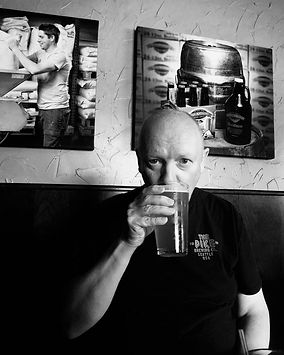
Known as the beer professor, Neil Reid is teaching a course this semester called “The Geography of Beer and Brewing.” That’s right, a graduate level course all about beer. Studying the industry for about five years now, Reid is an expert on all things craft brewing and has published scholarly and light hearted articles about the subject. Later this month, he will be giving the keynote speech at the 10th annual Wisconsin Hop Seminar.
What is the craft beer industry all about?
“The craft beer industry started back in the 1980s and has grown quite rapidly since then. Today, there are over 7,000 craft breweries all across the United States. Basically, the reason they began to appear back in the 1980s and continued to grow [was] because people were growing dissatisfied with the beer that was being sold by the big, multi-national companies like Budweiser or Miller. This small number of large brewers were all producing homogeneous beer that all really tasted the same and consumers wanted more choice.”
Tell me about the industry’s history.
“Until 1979, craft brewing had been illegal across America since prohibition and it began taking off since then. It started as a hobby and as people got better, they wanted to begin sharing it with the public, so brewpubs and microbreweries began popping up everywhere. The market for craft beer is basically two types of people, there’s young people, the millennial demographic that’s looking for something different, more diversity and flavor in beer. The other piece [is] people who want to support locally-owned businesses, because most craft breweries are owned by someone who lives in that community. The craft beer industry composes about 12 percent of the industry, but it’s more expensive, so if you look at it in terms of sales, craft beer is over 23 percent of market. That is quite significant and it’s challenging the very large breweries.”
What made you want to begin researching the industry?
“I began in 2014 and my field is economic geography, so I’m interested in industry, and economy, and how they work. I knew about craft beer long before I began studying it, and then it hit me that it would be a really interesting area to study because it is changing so fast.”
Is this the first time the class has been taught?
“Yes, this is the first time I’ve taught it, so it’s somewhat experimental. It is a graduate level class, so it’s masters and Ph.D. students. What that means is that it’s a very reading-intensive class. Students will read anywhere from 125-150 pages of research articles every week. It’s not really a lecture-led class. It’s all discussion based. I choose a range of topics to focus on each week, like for the first week, I started from the beginning with the history of beer and brewing. Another topic we’ll look at is something called beer-tourism, something that’s becoming popular where people will actually plan travels specifically to go to certain breweries.”
Will the course be taught next year?
“Yes, I’ve talked to my Chair and I believe I will teach it again next spring.”
Could it ever be transitioned into an undergraduate course?
“This could easily be taught as an undergraduate class. It would have to be taught in a very different way. In other words, it would be much more a lecture-based class. It could definitely be possible; it’s something I would have to talk to my chair about and then I would need to develop the material for the course.”
How long have you had your blog, thebeerprofessor.com?
“It has been since April 2015. I’ve published quite a few academic papers on the topic, but those are mainly read by other academics. What I wanted to do was have a format where I could do short, non-scholarly pieces just for fun. A lot of the blogs are travel-based. I do quite a bit of traveling for conferences and will try to make a point to visit the different breweries where I am.”
Will it be your first time attending the conference?
“Yes, it is my first time attending this one. I am giving the keynote and it’s actually a really specialized conference. It’s called the Wisconsin Hop Seminar.”
Can you describe the process of making beer?
“Beer is basically made from four ingredients, you have water, yeast, barley and hops. Hops give beer its bitterness, as well as different flavors and aromas. Most of the hops in the U.S. are grown in Washington, Oregon and Idaho, basically the Pacific Northwest. In recent years, craft brewers have been looking locally to find people producing hops and hop farms are now popping up in other parts of the country with Wisconsin being one of those areas. They’ve had this seminar now for 10 years, where they bring together brewers, hop farmers and university researchers to talk about the hop industry and to network and connect.”
Does our area have a large craft brewery industry?
“Some of the best craft breweries in the country are in Michigan, and the state is actually number four in terms of hop production, which is really driven by Michigan brewers wanting to use local hops. Ohio has around 230 craft breweries. Not surprisingly, Cleveland, Columbus and Cincinnati have the most craft breweries. We have about six or seven here in Toledo, depending on how you count them. I think in Toledo we are undersupplied and given the size of the population, we could probably support twice as many. That will happen, but it happens slowly, because basically what it takes is someone who’s homebrewing right now to make the decision to do it as a career.”

